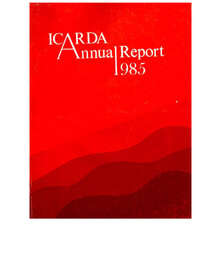ICARDA Annual Report 1985

Authors:
ICARDA Annual Report 1984/85 major highlights:
Harsh season with severe frost (19 days, down to -10°C) followed by hot, dry weather. Crops were badly damaged, but conditions allowed scientists to test germplasm under combined frost and drought stress.
• Barley: breeding for stress tolerance using advanced techniques and wild relatives (Hordeum spontaneum).
• New varieties released: 3 barley (Tunisia), 2 durum wheat (Algeria), 1 lentil (Ethiopia), 1 chickpea (Cyprus).
• ICARDA material has been widely tested in Syria and over 15 other countries.
• Lentil mechanical harvester developed, tested in Syria.
• Forage legumes after barley increase profits by up to 75% and sheep flocks by 100%.
• Medicago rigidula identified as frost-tolerant forage; vetches bred for disease and frost resistance.
• Fertilizer (especially phosphorus) has been shown to increase barley yields, profits, and reduce yield variability.
• Large variability in climate and soils requires zone-specific cultivars and practices.
• Ongoing research into rotations, tillage, fertilizer management, supplemental irrigation, and crop modeling.
• Strengthened ties with Ethiopia, Iran, Iraq, Jordan, Morocco, Tunisia, Turkey, Pakistan, and Syria.
• Expansion of the Nile Valley Project (Egypt, Sudan, Ethiopia) and new Quetta Project (Pakistan).
• Increased national program responsibility for trials and cultivar evaluation.
• 225 participants trained (up from 203 in 1984).
• Long-term and short courses held in Aleppo, Morocco, Pakistan, and Syria.
• New collaboration with Montana State University on barley breeding.
• 15,026 germplasm accessions distributed to 24 countries.
• New virology lab established to survey viral diseases.
• Strong emphasis on soil and water conservation and sustainable agriculture.
• Building construction at Tel Hadya delayed, expected completion in 1987 (ICARDA’s 10th anniversary).
• Continued strong donor and host country (Syria) support.
